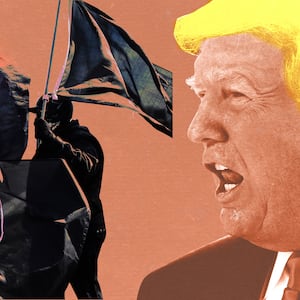The FBI has failed to produce a legally required report detailing the scope of white supremacist and other domestic terrorism, despite mounting concerns that the upcoming election could spark far-right violence.
According to a key House committee chairman, that leaves the country in the dark about what the FBI concedes is America’s most urgent terrorist threat, as well as the resources the U.S. government is devoting to fight it.
In June, the bureau was supposed to release a report compiling a wealth of currently unavailable data on domestic terrorism, a category that includes white supremacist violence. The most recent National Defense Authorization Act (NDAA) requires the FBI, in accord with Department of Homeland Security and consultation with the Office of Director of National Intelligence, specify not only known acts of domestic terrorism, but “ideologies relating to domestic terrorism,” and what the FBI and its partners are doing to combat it all.
Yet the FBI is over four months late. While President Trump falsely portrays left-wing property damage as terrorism, suspicion is building that the FBI, whose director Christopher Wray is on the outs with Trump, will keep the public from seeing the scope of its premier terror threat before an election that may feature violence emerging from it.
“I would hate to think that they are reacting to President Trump’s machinations about his dislike for senior leadership in the FBI,” Rep. Bennie Thompson, the Mississippi Democrat who chairs the House Homeland Security Committee, told The Daily Beast. “This report probably would not be viewed favorably by this administration. That, I think, precipitates the report not being released by Nov. 3.”
The public, Thompson continued, “needs to know who the real, documented terrorists in this country, based on the FBI’s intelligence, really are. … I think [Wray] understands that if he wades too far in the water around this subject, he might drown, or get fired, to be honest.”
The FBI did not deny that the report will not be in time for the election.
“The report referenced is a joint product in coordination with ODNI and DHS. NDAA language breaks the report into two parts. Due to limitations caused by COVID-19, Part 1 of the report is in the interagency review process. Part 2 is still being drafted. The FBI is committed to continuing with ODNI and DHS on the report and meeting NDAA requirements,” an FBI official said in a statement to The Daily Beast.
The domestic terrorism report mandated by the NDAA—thanks to Reps. Thompson, Adam Schiff (D-CA) and Andre Carson (D-IN )—is supposed to include everything from how many agents and intelligence analysts the FBI and DHS assign to domestic terror; to a tally of violent incidents stretching back to 2009; to “the rankings of domestic terrorism in relations to other threats” in each of the FBI’s 56 field offices. It’s also supposed to detail “the necessity of changing authorities, roles, resources or responsibilities within the Federal Government to more effectively prevent and counter domestic terrorism activities.”
Its entire purpose is to fill a critical knowledge gap—“to understand prevalence,” particularly of white supremacist violence, said Elizabeth Neumann, who from March 2018 to April 2020 was the assistant secretary for counterterrorism at DHS. “How big a problem do we have? We can’t answer that in the United States.”
Wray testified to the House Homeland Security Committee that white supremacist violence is “the biggest chunk” of domestic terrorism. That’s an indirect way of acknowledging that white supremacist terrorism, not jihadist terrorism, is the major terrorist threat the United States faces in 2020. It should be obvious: white supremacist terrorism draws from 400 years of American history. No other form of terrorism is as deadly, resilient and authentically American.
The FBI recently broke up a plot in Michigan by a group of armed right-wingers to kidnap Gov. Gretchen Whitmer and possibly Virginia Gov. Ralph Northam. Law-enforcement actions against white supremacist militants have been on the rise, including last week’s charges in three states of members of a white-power gang. “I have no doubt the FBI is on top of any number of cases of this. I have confidence that the FBI is likely to thwart a lot of these attempts,” Neumann said.
Those who monitor or have fought white terror consider those moves welcome—if overdue and incomplete. “If they’re doing the right thing, they could prove it by complying” with the required information disclosures, said Mike German, who as an FBI special agent in the 1990s infiltrated and arrested white supremacist militants. “They’re masking the data, which leads me to say their rhetoric, while appreciated, just acknowledges the obvious.”
Now a score of national security veterans are sounding alarms about the potential for election-timed violence from those elements, particularly as they feed on a steady diet of incitement from the president falsely claiming the Democrats plan on stealing the election. Rep. Elissa Slotkin, a former CIA analyst and senior Pentagon official who now represents a Michigan district where three of the militiamen lived, expects unrest. “I don’t think we’ll see widespread violence, but it wouldn’t surprise me if we saw limited skirmishes,” said Slotkin, a Democrat. Even a long-delayed and equivalence-laden DHS report—one accused by a whistleblower of deliberately downplaying white extremism—said that “campaign-associated mass gatherings, polling places, and voter registration events” were the “most likely flashpoints” for election-timed violence.
The FBI’s discussions of white supremacist terror are circuitous and euphemistic, adding to the opacity. The FBI categorized white supremacy as one of 11 subcategories of domestic terror it monitored, but a recent bureaucratic reorganization subsumed white supremacy within a broader category called “racially motivated violent extremism.” That implies proportionate nonwhite violent extremism that doesn’t exist. “I think it’s the glossing over of a problem,” said Thompson.
Neumann was the chief DHS counterterrorism official when the FBI created its “racially motivated violent extremism” category. “I didn’t get a sense, at a counterterrorism level or an FBI level, that people were trying to avoid the rise of white supremacy. We were talking about how this has gone global, we’re the exporters of it, and there was alarm,” she remembered. But the FBI’s intelligence priority is generating casework for prosecutions, rather than developing an overall threat picture from a domestic terror network. If Neumann wanted to know about “a particular cell of ISIS in Africa,” and how it had changed over a period of time, many government intelligence analysts could provide it. “I can’t get that level of granularity from a domestic terror perspective,” Neumann said, “and the only entity capable of producing that is the bureau.”
As recently as 2018, the FBI considered far-right extremism “the lowest priority” amongst its counterterrorism efforts, according to a knowledgeable FBI veteran at the time. However, former DHS chief of staff Miles Taylor considered Wray attentive to the problem back then. “Chris Wray dedicated more and more people out in the field to these cases,” Taylor recalled.
But 2019, according to domestic counterterrorism veterans, was the crucial year for the surge in such violence. Partial statistics, contained in the DHS report, show that in 2018 and 2019, white supremacists committed half of the 16 violent attacks attributed to all domestic extremists and killed 39 of the 48 people slain in all those events.
Yet when Senate Democrats objected to the FBI’s change in terrorism classifications in May 2019, they learned that administration officials “could not say how many [domestic terror incidents] involved white supremacist violence, other than to acknowledge they were ‘a majority’ of the incidents.” As late as October 2019 Wray was still saying that foreign-inspired “homegrown violent extremists”—a euphemism for jihadis—were “the greatest, most immediate terrorism threat to the homeland.”
The FBI official told The Daily Beast that in fiscal 2019, it arrested 107 “domestic terrorism investigation subjects,” without specifying how many were white supremacists, and 121 international terrorism subjects. “However, for the previous two fiscal years, the FBI arrested more subjects of domestic terrorism investigations than international terrorism,” the FBI official said.
The disconnect between the white terror threat and its characterization sparked the requirement in the NDAA for the FBI to compile its domestic-terrorism report. Last month, Wray revealed that the FBI now had over 1,000 domestic terrorism investigations open—but he didn’t specify how many focus on white supremacist or far-right terrorism, two overlapping but distinct categories.
Still, Neumann and Taylor considered the broader problem not to come from the Hoover Building, but the White House. “There was never a moment where someone came and told us we can’t talk about white supremacy. I was waiting for it. I expected it. No one told us that, though,” Neumann said. “Rather than trying to suppress us, they weren’t taking what we were doing and prioritizing it. It was the lack of prioritization and the lack of the president saying this is a concern. It wasn’t an intentional or obvious suppression, but a lack of prioritization.”
Taylor added, “The bottom line from the White House was they didn’t want us to talk us about domestic terrorism because they worried that if we talked about right-wing extremism, we would alienate many of the president’s supporters.”
The White House has denied such characterizations. “Intelligence officials work around the clock to monitor every range of threats facing our nation, including domestic terror,” spokesperson Alyssa Farah told Politico’s Betsy Woodruff Swan in August, when DHS’ account first emerged.
Wray is getting a wide berth on Capitol Hill. Whatever their criticisms of him, congressional Democrats do not see him as a Trump loyalist, unlike the acting DHS secretary, Chad Wolf, or Wray’s boss, Attorney General Bill Barr. They’re apprehensive of pushing Wray in directions that might provoke Trump’s ire or jeopardize the FBI’s independence. Trump has spoken to associates about firing Wray, prompting Sens. Chuck Schumer and Ron Wyden, both Democrats, to urge Wray against “a partisan investigation” into Joe Biden “on the eve of the election.”
Wray also has his defenders within the FBI veteran community, including from retirees who have long urged the bureau to focus on white terrorism. “They didn’t just start investigating these guys [in Michigan] in August. Undercovers go on a long time,” said Erroll Southers, a former FBI special agent and California homeland-security official who teaches at USC. “It appears to me they are putting the resources they have on the target,” agreed Andrew Arena, the former special agent in charge of the FBI’s Detroit field office, who conceded Michigan’s reputation as a locus for armed groups on the far right.
Still, Southers struggled with Wray’s contorted presentations of white supremacist terrorism. “Wray has to play a certain game, but it does send a mixed message,” he said. “It’s disappointing when they can’t call a duck a duck.”
Farhana Khera, the executive director of the civil rights group Muslim Advocates, has less patience. For a generation, the FBI has placed the American Muslim communities across the country under a blanket of suspicion. It has mapped their businesses, infiltrated their places of worship, and, in an extreme case, taught junior agents that their religion is the source of the terrorist threat to the country. Its few Muslim officers face internal hostility. An Obama-era program known as Countering Violent Extremism (CVE) presented itself as community-led outreach, but described itself in internal documents as the “intelligence gathering” program many Muslims always suspected it to be.
“For the last 20 years, we’ve often heard from federal law enforcement about their efforts undertaken to understand these [Islamist] groups, motivations, recruitment and methodology,” Khera noted. “We don’t hear that from federal law enforcement when it comes to these [white] groups.”
The lack of any proposal for counter-extremism in white communities “shows the lack of substance to the whole concept behind CVE,” added German, the former FBI agent now at the Brennan Center for Justice. “It always has been about what we’ve been arguing about: suppressing marginalized communities rather than trying to prevent violence.”
Thompson, the House Homeland Security Committee chairman, made a similar point.
“The White House, members of Congress, other outside groups, are saying ‘these radical Muslim groups, these radical left-wing groups, we gotta do something about them.’ Well, it was clear that when you talk to professionals, these weren’t the most dangerous, nor from a numerical standpoint—the statistics were going in the opposite direction,” he said. “We’re still having these incidents occur, but the ideology and the individuals perpetrating them lean more toward the right-wing philosophy. And I think, when that hit, it kind of took the fire out of the domestic-terrorist conversation.”
Thompson said that without the report, it was impossible to tell how adequately the FBI was dealing with white-supremacist or right-wing violence.
“For a long time I operated on the perception that the FBI was above politics. That we have a 10-year [term for a] technical person at the head, and you give that kind of longevity to make that individual above politics,” he continued. “Here we are, and almost on a daily basis, the president is threatening to get rid of him for various and sundry reasons.”




